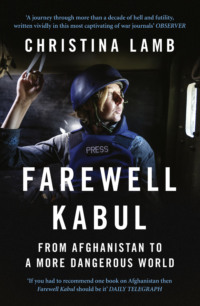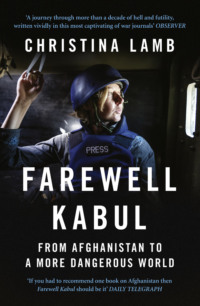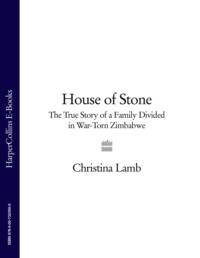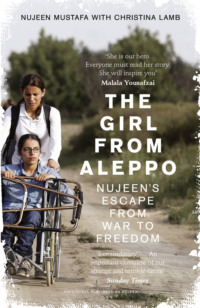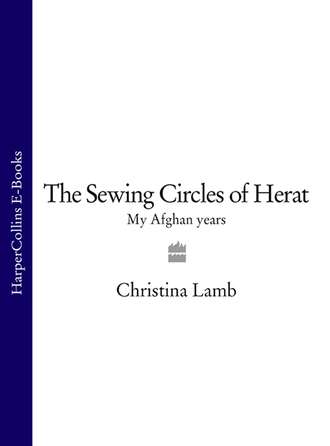
Полная версия
The Sewing Circles of Herat: My Afghan Years
Our destination was Abdul Razzak’s secret training camp cum madrassa or religious school in an area called Khunderab, inside a narrow gorge hidden by overhanging mountains, the entrance blasted out of the rock with dynamite. A guard sat at a table, an old black telephone in front of him. Abdul Razzak explained it was part of a wireless phone system captured from the Russians, and enabled camp-guards to call a military post on top of the mountains where they had men stationed with anti-aircraft guns if an enemy approached.

The camp, which acted as a training and rest camp for fighters for the Mullahs Front, had existed for about a year, moving there after the previous site was bombed by Soviet Mig 17s for seventy-four hours continuously, destroying all their weapons and killing fifty men. ‘There were forty planes dropping 3000 bombs,’ said one man with what I presumed was the usual Afghan exaggeration of multiplying everything by ten, ‘it was the only day we couldn’t pray.’
Prayer was an important feature of camp-life. The camp was home to eighty men and forty-two students aged from eight to eighteen and Abdul Razzak took me to see the school where children studied the Koran and Arabic. We watched a recitation lesson, boys rocking back and forth as they intoned the words of the Koran, and Abdul Razzak gave some religious books he had brought from Quetta to the white-bearded teacher. Hamid told me that for boys educated in madrassas, the rocking becomes such a habit that later in life they cannot read without it. Had we but known it, we were seeing the incipient Taliban. In my diary I wrote: ‘Mohammed Jan is eight. After Koranic lessons he learns how to load a BM12’.
Next we saw the boys’ dormitory – camouflaged from above with a roof of tree branches and hay that allowed air to circulate, keeping it cool inside. A small boy sat in the doorway cleaning a pile of Kalashnikovs. There seemed to be weaponry everywhere. ‘We have thirty-five RPG7, forty-two RR82mm recoil rifles, seven anti-aircraft guns,’ said Razzak. They also had two Stinger missiles left of an initial six which they received in November 1987, kept under twenty-four-hour guard, though they happily took them out to pose for photographs. Nine hundred of these heat-seeking missiles had been provided by the Americans to the resistance in 1986–7 along with British Blowpipes and were thought to have turned the tide of the war by countering the threat of Soviet air superiority though many were instead sold on to Iran, forcing the CIA to launch a buyback programme which did not stop them later turning up everywhere from Angola to Algeria.
The camp was run by Abdul Razzak’s friend Khadi Mohammed Gul who said he was twenty-eight but looked at least ten years older. He told me he had wanted to be a mullah, a village priest, but had joined the resistance and in 1983 been captured by the Soviets and sent to Pul-i-Charki, the notorious prison on the outskirts of Kabul. Run by KHAD, the East-German trained Afghan secret police, it held around 10,000 political dissidents. He was there for four years until he was released in a prisoner swap when Razzak captured a top commander from the Afghan regime.
Survivors of Pul-i-Charki were rare and I asked him about life there. ‘We knew whenever the Soviets had suffered heavy casualties because they would take a whole lot of prisoners, remove their blood for transfusions then shoot them,’ he said. He also told of awful tortures. ‘Sometimes it would be electric shocks to the nose, ears, teeth and genitals, so many that now I am impotent. Other times they tied us to trees with our feet on broken glass and left us for several days until the wounds went rotten and there were maggots inside. Another punishment was to give us food with laxative or something bad in to cause diarrhoea then leave us in a room one meter square so we would have to live in our own excreta for days. Sometimes at night they would call someone’s name and we would know he was being shot but we would say “bye!” as if he was going for a trip but we knew he’d never come back.’
The words hung heavily in the air and we sat there for a while in silence. Then I asked to see the rest of the camp. There was a clinic with a few lint bandages and a box of aspirins where a doctor was cleaning a horrible suppurating wound on the thigh of a fighter who sat silently despite the agonising treatment, and a bakery where young boys were slapping flat wide oblongs of dough onto the wall of a large clay pot buried in the ground with hot coals in the bottom to make nan, the traditional unleavened bread. Some other boys were scrubbing clothes in the small river and it was hard not to notice the red staining the water. A few goats and sheep were grazing and there was a small plantation of okra or ladyfingers as well as several apple trees so the camp was more or less self-sufficient.

The camp had strict rules, one of which was ‘men must be taught religious teachings as much as possible’. Everyone was checked at the gate and there were heavy penalties for sneaking out weapons or ammunition.3 ‘You see we are not like those other groups which steal the money and sell the arms to the Iranians,’ said Gul. ‘This is what jihad is meant to be.’ He pointed out that many villagers used the clinic, which was the only medical facility for perhaps fifty miles, and all wanted their boys to be accepted to study at the school as free board was provided.
It was the first time I had seen a mujaheddin group making an effort to provide facilities to civilians. At the main gate as we were leaving, an exhausted ten-year-old boy named Safa Mohammed had just arrived ‘to join the resistance’ after a fourteen-hour walk through the mountains. ‘My father was killed by the Russians and I ran away from my mother,’ he said. ‘First I want to study but when I grow up I will carry a gun and kill Soviets.’
It was evening as we drove away, bumping across rutted mountain tracks, headlights off to avoid being spotted by a Russian plane. The area was heavily mined so two brave men walked in front of the wheels of the jeeps, testing the ground as we followed slowly behind. Of all the many ways to die or be injured in Afghanistan, mines were the scariest. The Soviets had scattered them everywhere, including what the mujaheddin called jumping mines, designed to bounce up and explode in the genitals, and even some disguised as pens and dolls to entice children. Most were butterfly mines dropped from the air, which maimed rather than killed and thus took out more resistance firepower as men would be needed to carry the victim. No one knew how many mines there were – the latest figure from the US State Department was more than ten million – nor their whereabouts, for contrary to all rules of warfare the Soviets had not kept maps.
I had seen far too many victims in the hospitals of Peshawar with legs or arms blown off, eyes missing or guts hanging out, as well as all the people in the bazaars and refugee camps with stumps for limbs and had taken to identifying interviewees in my notebooks as ‘man with beard and two eyes’. My head throbbed from concentrating as I scoured the land in front for mines and scanned the skies, for somewhere among the many stars there might be a Soviet Mig.
It was 2.30 a.m. when we arrived at our destination of Argandab, a valley of orchards about ten miles west of Kandahar which Alexander the Great had used as a camp for his army of 30,000 men and elephants and was now an important base of the resistance. Mujaheddin love gadgets and someone turned on flashing fairy lights to herald our arrival after all our efforts to be invisible. The rumble of guns was not far off but I fell asleep to the soothing sound of running water from a river.
As we breakfasted the next morning on salted pomegranate pips, I saw that the whole area was pitted with holes from bombs, in between which were clusters of mujaheddin graves made from little piles of stones with small tattered green flags stuck on top. The shelling was relentless, sometimes so near that dust sprayed over us, but none of the mujaheddin sitting around seemed to pay any attention to it. Hamid told me that when he was growing up this had been a favourite picnic spot with its orchards of apricots, pomegranates, peaches, figs and mulberry trees but that was hard to imagine. The crop had all been destroyed in the fighting or rotted because there was no labour for picking and the Russians had destroyed the karez, or irrigation channels to stop the mujaheddin using them for cover. As we talked a delegation of Popolzai arrived, led by Mullah Mohammed Rabbani, overall commander of the Mullahs Front, all of whom seemed overjoyed to see Hamid, embracing him to the right, to the left and right again in the traditional way, then shaking his hand.
I began to realise the importance of his visit and the risk he was taking. He had told me the previous day that he was high up on the Soviet hit list and I wondered whether the fact that we were bombed everywhere we stopped was really a coincidence. I wished he wouldn’t keep radioing everyone to say we had arrived. That morning as we sat under a tent of camouflage material, he told me, ‘The first casualties in Kandahar were forty from my family. The four most important were taken to the Governor’s house, laid on a big rug and huge rocks thrown on them from above to smash their skulls. Afterwards the carpets had to be taken to Bawalpur to be washed.’
There was a roar of engines and several turbaned men on motorbikes shot into the orchard. It was incongruous seeing these medieval bearded figures on their Yamaha motors and I started to laugh, but Hamid got up to greet the heaviest one. I recognised Ratmullah, who had left us the previous day and was now back with some of his fellow-fighters.
‘The bikes are the best way to get around quickly and not to be seen,’ he explained as he dismounted. ‘Anything bigger gets picked out and shot.’ When there was a lull in the shelling, we set off on the motorbikes, bumping across plains which looked like the set of a war movie crisscrossed with muddy trenches, something I had never seen before in Afghanistan. I held on to the back of Ratmullah’s bike, shouting ‘you’re Allah’s Angels!’ which he didn’t understand but we both laughed, my turban unravelling all round my face as we hurtled along.
Passing a tall concrete silo for storing wheat, we were suddenly riding along a paved highway, the Heart – Kandahar road. The stretch we were on was controlled by mujaheddin and just in front of a blue-domed tomb which had somehow survived intact and that housed a mujaheddin camp, they had built a wall along the road consisting of tanks and armoured personnel vehicles turned on their sides, moving each one into place after it had been destroyed. I counted eighty-two. It felt very exposed particularly as we came to a bend in the road beyond which we could not see. ‘Is this safe?’ I shouted to Hamid but his words were lost in the wind and I only caught what sounded like helicopter. Later he told me he had said we were fine as long as no helicopters came in which case we were dead.

Motorbikes were less likely to be spotted by Soviet planes.
It was a relief when we turned off the road and rode through some orchards of rotting pomegranates. In the distance we could see plumes of thick black smoke. Finally we came to Malajat, an area that had seen so much fighting that all its inhabitants had fled, leaving just the resistance. The mujaheddin post where we were to stay was the homeliest I had seen, the usual earthen-walled house but with a garden decorated with pots of pink and red geraniums and a small shed which turned out to be an improvised shower-room where one stood under an upside-down water bucket full of holes.
The commander of the post was Bor Jan, a squat man with a shaved head who looked like a friar in his black robes and served us green tea and boiled sweets using a Russian parachute as a tablecloth. He had been an officer in the Afghan army but at the time of the Communist takeover went into a madrassa where he joined forces with fellow religious students Abdul Razzak and Mullah Mohammed Rabbani. ‘Of the original ninety persons there are only eight of us left,’ he said. ‘I cannot describe the suffering.
‘We went to join Harakat of Maulvi Mohammed Nabbi Mohammedi because at the beginning that was the most powerful group militarily. To start with we just had a few guns from the gun-shops at Darra [a Pakistani tribal town famous for copying guns] but we captured more and slowly spread. We were the first mujaheddin to do conventional fighting – trench warfare – because the terrain here is not suitable for guerrilla methods. In 1982 we left Harakat and joined Khalis to get better arms.
‘The Front was started by Abdul Razzak and he sent sub-commanders to various districts whom he had recruited directly and pays all their expenses. Now we have two thousand people in three areas – Argandab, Malajat and Zabul.’
I asked about the command structure and Bor Jan explained; ‘We communicate by letter because we don’t have radios and even if we did maybe they wouldn’t be safe. Usually we carry out joint operations where each sub-commander brings five or ten men and then the spoils are divided. Disputes are resolved through local systems of elders or religious scholars but if that fails they go to a special Islamic court where a man called Maulvi Pasani decides.’
All of them were very bitter about Pakistan and the Peshawar leaders. ‘For every one rupee aid given to the resistance, we get one paisa. We only have two clinics for our wounded in Quetta which is two days away while there are hundreds in Peshawar.’
Although Bor Jan claimed to be helped by the civilians inside the town, he said his men often went hungry. ‘Once during heavy Soviet bombing we had no food for twenty-five days and we lived on grapes. Now we keep leftover bread in bags and store it for hard times.’ He pulled out a sack to show us and I felt a piece of the bread. It was rock hard. ‘Last winter we lived on this for one hundred and eighty-two days,’ he said.
We stayed at Bor Jan’s post for about a week. I was not allowed to venture outside the post as it was made clear that it would look extremely bad for the Mullahs Front if it got out to anyone, particularly other mujaheddin, that they were harbouring a Western woman. They seemed far more worried about this than about being attacked by the Russians. I grew to hate my turban, which was hot and heavy in the boiling desert sun, my hair damp and sweaty underneath, but I was never allowed to remove it. ‘Remember, you are a Kandahari boy,’ they said to me, something I discovered had hazards of its own in a region where men are known for their liking of young male flesh.
One afternoon another motorbike roared up and we were joined by Ehsanullah Ehsan Khan, another Popolzai, whom everyone called Khan Aga or Uncle Khan. Frowning at me, he said he was the son of Saleh Mohammed Khan who initiated the 1954 insurgency against the liberation of women and burnt the movie hall and girls’ school. ‘The Communists took him to the Governor’s house and dropped a stone on his head,’ he added.
There was not much to do. Once we went on a crazy night-time raid on a government defence post in the centre of the city which involved us leaving the motorbikes in a flour-mill, tiptoeing past a Communist post so close that we could hear the radio inside, then hiding in the woodcutters’ bazaar until a signal was given at which everyone fired their weapons then fled back through the empty streets and along the ridges between irrigation canals.
Mostly we did nothing. I became accustomed to sitting in Bor Jan’s garden writing my diary with bullets whizzing one side and rockets the other, and chatting to his men. When they were not cleaning their guns, clipping their nose-hairs or tending their beloved flowers, those that were literate would read the Koran. There was none of the hashish smoking I had encountered on previous trips though plenty of chewing – and spitting – of tobacco. I was provided with a Kalashnikov-wielding bodyguard, a solemn-faced nineteen-year-old called Abdul Wasei to stand in front of the door while I washed off my coating of dust in the bucket-shower, which after a week without washing, felt like a five-star bath. They even made me a bed, which was wonderful until I realised that I was sleeping on boxes of ammunition.

Abdul Wasei, a nineteen-year-old former raisin cleaner who was my bodyguard.
Ratmullah had found a little sparrow, which he tied by string to a multi-barrel rocket-launcher and it would jump around squawking. Some of the fighters amused themselves by firing their Kalashnikovs near it and betting how high it would jump.

Ratmullah.
One day Bor Jan told us we were going to attack the airport. The plan was to depart at dawn but we left in the late morning, about twenty of us, all on motorbikes. I sat behind Ratmullah, trying to balance without touching his body so as not to offend him and consequently almost falling off. It felt good finally to be outside the post until in a field of green corn we passed an abandoned tractor, the driver’s body hanging awkwardly over the side. His brains had been blown out.
We hid the bikes in a branch-covered hole in a mulberry wood and, passing under a Koran held up by Ratmullah, we ran through the trees and down into one of the trenches that the mujaheddin had dug around the city. In the distance were some hills, beyond which was the airport. Some of the men took up position behind the trench in a tower used to dry grapes and began firing rockets at the airport, hoping to blow up a plane or an oil-tanker, though it seemed to me much too far away.
A shout went up and I just caught the fleeting panic on Ratmullah’s usually serene face before he pulled me to the ground under his huge weight. Two Russian tanks had appeared on the crest of the hill and were rolling down towards us. There was a dull thud as one of them fired and the grape tower behind us went up in smoke. As hot dust and rubble rained down on us Abdul Wasei dragged me into a shelter dug into the side of the trench. We could hear the cries and whimpers of the wounded but there was nothing we could do. If we emerged from the trench, we would be shot.
For two days we stayed there trapped while the tanks resolutely refused to go away. The cries behind us stopped and the silence was almost worse. We had nothing to eat or drink and my tongue felt thick in my mouth. There was a pool of muddy water in the trench and the others scooped it up with their hands and drank. Dead mosquitoes were floating on top but in the end I gulped down the dusty-tasting water, wryly remembering the British diplomat in Islamabad who had advised me ‘whatever you do, take your own cup to Afghanistan to avoid catching anything’. Ratmullah suddenly jabbered excitedly in Pashto, holding something up in his chubby hands. It was a mud-crab. I watched in horror as he bit into it, making noises of delight. Soon everyone was looking for mud-crabs and chewing them happily.

Eating mud crabs in the trenches.
Finally on the second day the tanks retreated back up the hill, presumably deciding we must all be dead. We ran crouching along the trench then out and back into the mulberry woods where our bikes were still where we had left them. When we got back to the post and were sitting drinking green tea, I put on my radio. After the usual crackle and static, I found BBC World Service and the unmistakable gravelly voice of Louis Armstrong singing What a Wonderful World. It was one of those moments you know you will never forget. Exhilarated at still being alive, I asked Abdul Wasei if he was ever scared. He shook his head. ‘That would bring dishonour on my family. A coward running away will not be buried in Muslim rites. Instead he becomes a ghost so will never reach Paradise.’
That night as it was our last dinner before leaving, we had rice with little bits of meat and bone, eaten scooped up in our hands. The next day, on the way back to Pakistan, I realised that the sparrow had disappeared.
The more times I went into Afghanistan to cover the war the more I realised that there were many realities and the best I could hope for was a few fragments, never the big picture. But always within a few days of returning ‘outside’ to the comfort of Peshawar and the luxury of plentiful food and clean clothes, there would come an aching hollowness and I would spend all my time trying to get back inside. War was an addiction and I was badly hooked.
‘No foreign editor is worth dying for,’ said someone older and wiser who saw what was happening to me but I laughed, downed shots of the smuggled vodka we referred to as ‘Gorbachev’ and went swimming at midnight in the Pearl Continental pool to the outrage of the hotel management. The ragtag mujaheddin of the mountains with their plastic sandals and Lee Enfield rifles were defeating the powerful Red Army with all their tanks and helicopter gunships and these were glory days.
That was before Jalalabad.
Jalalabad was different. By then it was March 1989 and the Russians had finished withdrawing their troops from Afghanistan. After years of guerrilla warfare the pressure was on the mujaheddin to show that they could capture and control a town. ‘It’s time to fish or cut bait,’ said an American diplomat with a southern twang at the weekly ‘Sitrep’ and we knew it was battle on. Kabul was the ultimate prize, but snug in its nest of tall mountains, the city presented too difficult a target. So the royal winter capital of Jalalabad was chosen as it was only fifty-eight miles from the Pakistan border and thus logistically easy. There were no secrets in Peshawar though plenty of misinformation and rumour. Everyone knew that the Pakistani military advisors were working on a plan. We all wanted to be the first one there.
One evening when I was in Islamabad the phone-call came. ‘It’s starting.’ Quickly I dressed in my mujaheddin gear of shalwar kamiz, rubbed permanganate powder mixed with earth into my skin to darken it, tucked my hair into a flat wool pakol cap, and wrapped a woollen shawl around my shoulders. By then, as a fully paid-up member of the War Junkies Club I also had a mud-spattered US army jacket. I grabbed my small rucksack and jumped into my little Suzuki car weaving my way though the camels and arms trucks up the Grand Trunk Road to Peshawar to meet with the group of guerrillas I was planning to travel with. They had bad news. The border had been closed by ISI and no journalists were to be allowed across.
The commander was a friend and willing to take the risk so we left immediately, crammed in the back of a jeep, up the Khyber Pass, a twenty-five-mile journey through narrow gaps in craggy mountains decorated with pennants of the Khyber Rifles and other frontier forces familiar from British history. The mountains were barren and not spectacularly high but it was always a thrilling drive, recalling the various British misadventures starting in 1839 when British troops marched up here on the way to the First Afghan War which ended in disaster in 1842, and back again in 1878 for the Second when they were again forced to withdraw. Each time hundreds of men had been killed just getting through this pass, controlled then as now by the murderous Afridi tribe famous for smuggling and complete untrustworthiness. Many of these men were buried near the Masjid mosque at the top of the pass. Nearby, at the Torkham border post, ISI were out in large numbers. An officer jumped in the back and shone his torch on our faces. I had my head down, my shawl covering me as much as possible.





